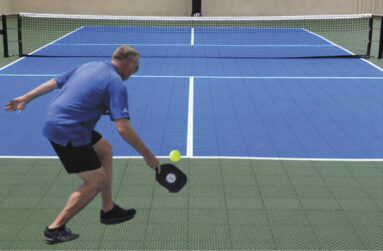Jonathon Colter
The game of pickleball is a fast-moving game often requiring good reflexes and good judgment. Quite frequently, a player’s shot inadvertently “flirts” with the white boundary lines resulting in questionable line calls. Why can it sometimes be so difficult to make an accurate call that all players agree with?
Here’s one reason why: Look at the first picture. If this picture was taken at the moment the ball landed on the ground, would the correct call be in or out? From this perspective, half the ball appears to be on the white line.
Now let’s look at the second picture where the ball landed in the exact same spot using a close-up angled front view:
The correct call based on this picture is out! No part of the ball made contact with the white baseline.
Similar pictures could be shown using sideline shots as well. The problem is simple. A player attempting to make a shot while simultaneously attempting to judge accurately whether the ball has landed in or out can easily make a questionable call.
So, what options do we have to handle a situation like this?
If the player making the call is certain of his or her call, the opposing team has four options:
1. Accept the call and move on to the next point. This is considered the most courteous and common way to play the game.
2. Alternatively, one could politely ask the opposing team’s partner if he or she saw whether the ball was in or out. If he or she saw the ball in, the final ruling should be in. If he or she could not make a definitive call in or out, the final ruling should remain out. This second option should only be used when both players feel certain the player making the line call was clearly wrong.
3. In rare circumstances, a point ends where both players on the receiving end of the shot are unsure whether the ball landed in or out. They can ask their opponents if they saw where the ball landed. If the receiving team chooses this option, they are bound by their opponent’s in or out call. If all four players are uncertain whether the ball landed in or out, the ball should always be ruled in.
4. If one is participating in tournament play, players have the right to turn to the referee for a second opinion on a line call. If the referee clearly saw the shot, he or she can overrule the call made by the participating player. If the referee could not clearly and decisively see the ball in or out, the final ruling stands based on the original player’s call.
Pickleball at PebbleCreek is predominantly about outdoor fun and play that brings our community together in a social environment to enhance our quality of living. Should one lose perspective of this while playing pickleball and feel the need to challenge players’ calls on a regular basis, there is a tool (we North Carolinians use) to help players refrain from such behavior. It’s called duct tape. It’s guaranteed to reduce controversy on the court (as well as in the home) … just ask my wife!


